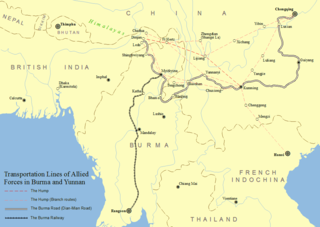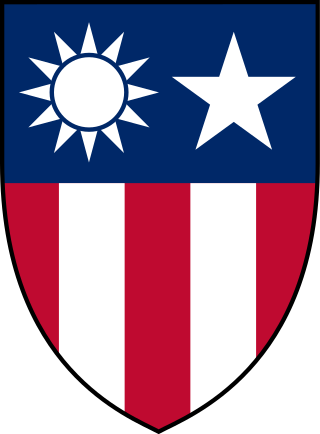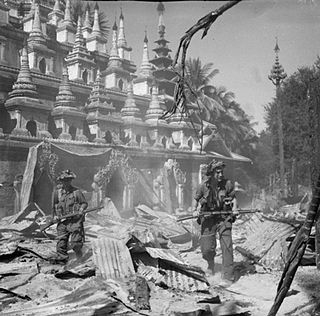
Joseph Warren "Vinegar Joe" Stilwell was a United States Army general who served in the China Burma India Theater during World War II. Stilwell was made the Chief of Staff to the Chinese Nationalist Leader, Chiang Kai-shek. He spent the majority of his tenure striving for a 90-division army trained by American troops, using American lend-lease equipment, and fighting to reclaim Burma from the Japanese. His efforts led to friction with Chiang, who viewed troops not under his immediate control as a threat, and who saw the Chinese communists as a greater rival than Japan. An early American popular hero of the war for leading a column walking out of Burma pursued by the victorious Imperial Japanese Armed Forces, Stilwell's implacable demands for units debilitated by disease to be sent into heavy combat resulted in Merrill's Marauders becoming disenchanted with him. The U.S. government was infuriated by the 1944 fall of Changsha to a Japanese offensive. Stilwell delivered a message to the Chinese Nationalist leader Chiang Kai-shek from President Roosevelt that threatened that lend-lease aid to China would be cut off. The resulting friction atop an already tense relationship made Ambassador Patrick J. Hurley advocate that Stilwell had to be replaced. Chiang had been intent on keeping Lend-Lease supplies to fight the Chinese Communist Party, but Stilwell had been obeying his instructions to get the Communists and the Nationalists to co-operate against Japan.
The 11th Army Group was the main British Army force in Southeast Asia during the Second World War. Although a nominally British formation, it also included large numbers of troops and formations from the British Indian Army and from British African colonies, and also Nationalist Chinese and United States units.

The Northern Combat Area Command (NCAC) was a subcommand of the Allied South East Asia Command (SEAC) during World War II. It controlled Allied ground operations in northern Burma. For most of its existence, NCAC was commanded by United States Army General Joseph "Vinegar Joe" Stilwell. In 1945 after Stilwell was recalled, his deputy, Lieutenant General Daniel Sultan, was promoted to and assumed command.

The Burma campaign was a series of battles fought in the British colony of Burma. It was part of the South-East Asian theatre of World War II and primarily involved forces of the Allies against the invading forces of the Empire of Japan. Imperial Japan was supported by the Thai Phayap Army, as well as two collaborationist independence movements and armies. Nominally independent puppet states were established in the conquered areas and some territories were annexed by Thailand. In 1942 and 1943, the international Allied force in British India launched several failed offensives to retake lost territories. Fighting intensified in 1944, and British Empire forces peaked at around 1 million land and air forces. These forces were drawn primarily from British India, with British Army forces, 100,000 East and West African colonial troops, and smaller numbers of land and air forces from several other Dominions and Colonies. These additional forces allowed the Allied recapture of Burma in 1945.

The Burma Road was a road linking Burma with southwest China. Its terminals were Lashio, Burma, in the south and Kunming, China, the capital of Yunnan province in the north. It was built in 1937–1938 while Burma was a British colony to convey supplies to China during the Second Sino-Japanese War. Preventing the flow of supplies on the road helped motivate the occupation of Burma by the Empire of Japan in 1942 during World War II. Use of the road was restored to the Allies in 1945 after the completion of the Ledo Road. Some parts of the old road are still visible today.

The South-East Asian Theatre of World War II consisted of the campaigns of the Pacific War in the Philippines, Thailand, Indonesia, Indochina, Burma, India, Malaya, and Singapore between 1941 and 1945.

China Burma India Theater (CBI) was the United States military designation during World War II for the China and Southeast Asian or India–Burma (IBT) theaters. Operational command of Allied forces in the CBI was officially the responsibility of the Supreme Commanders for South East Asia or China. In practice, U.S. forces were usually overseen by General Joseph Stilwell, the Deputy Allied Commander in China; the term "CBI" was significant in logistical, material and personnel matters; it was and is commonly used within the US for these theaters.

The Ledo Road was an overland connection between British India and China, built during World War II to enable the Western Allies to deliver supplies to China and aid the war effort against Japan. After the Japanese cut off the Burma Road in 1942 an alternative was required, hence the construction of the Ledo Road. It was renamed the Stilwell Road, after General Joseph Stilwell of the U.S. Army, in early 1945 at the suggestion of Chiang Kai-shek. It passes through the Burmese towns of Shingbwiyang, Myitkyina and Bhamo in Kachin state. Of the 1,726 kilometres (1,072 mi) long road, 1,033 kilometres (642 mi) are in Burma and 632 kilometres (393 mi) in China with the remainder 61 km was in India. The road had the Ledo-Pangsau Pass-Tanai (Danai)-Myitkyina--Bhamo-Mansi-Namhkam-Kunming route.

The Battle of Imphal took place in the region around the city of Imphal, the capital of the state of Manipur in Northeast India from March until July 1944. Japanese armies attempted to destroy the Allied forces at Imphal and invade India, but were driven back into Burma with heavy losses. Together with the simultaneous Battle of Kohima on the road by which the encircled Allied forces at Imphal were relieved, the battle was the turning point of the Burma campaign, part of the South-East Asian theatre of World War II. The Japanese defeat at Kohima and Imphal was the largest up until that time, with many of the Japanese deaths resulting from starvation, disease and exhaustion suffered during their retreat. According to voting in a contest run by the British National Army Museum, the Battle of Imphal was bestowed as Britain's Greatest Battle in 2013.

The efficient running of the North-east Indian railways during World War II became critical to the success of the Allied war effort in the South-East Asian Theatre.

Pangsau Pass or Pan Saung Pass, 3,727 feet (1,136 m) in altitude, lies on the crest of the Patkai Hills on the India–Myanmar border. The pass offers one of the easiest routes into Burma from the Assam plains. The pass lies on the famous Ledo Road and named after the closest village on Myanmar's territory, Pangsau, which lies 2 km east of the pass. India's undisputed easternmost point "Chaukan Pass" - east of Vijaynagar in the Changlang district - lies northeast of Pangsau Pass.

X Force was the name given to the portion of the National Revolutionary Army's Chinese Expeditionary Force that retreated from Burma into British India in 1942. Chiang Kai-shek sent troops into Burma from Yunnan in 1942 to assist the British in holding back the Japanese. These Chinese forces became broken up, and in the retreat out of Burma part of these forces entered India. These were cantoned at Ramgarh Cantonment in the Bihar Province, brought up to five-Division strength, and re-equipped and re-trained by American instructors at British expense.

Fort Hertz was a remote British Military outpost in northeastern Burma in the district of Putao in what is now the Kachin State near the present town of Putao. It was named after William Axel Hertz. Hertz led the first expeditions into the far north of Burma in 1888, was responsible for the 1912 Gazetteer of Kachin Hills area and served as the first Deputy Commissioner of the Government in the Putao District. The military post was established in 1914 and given the name Fort Hertz in 1925 on the retirement of William Hertz from the Indian Civil Service.

The Chinese Expeditionary Force was an expeditionary unit of China's National Revolutionary Army that was dispatched to Burma and India in support of the Allied efforts against the Imperial Japanese Army during the Japanese invasion and occupation of Burma in the South-East Asian theatre of the Second World War.

The Burma campaign in the South-East Asian Theatre of World War II took place over four years from 1942 to 1945. During the first year of the campaign, the Imperial Japanese Army with aid from Burmese insurgents had driven British forces and Chinese forces out of Burma, and occupied most of the country. From May to December 1942, most active campaigning ceased as the monsoon rains made tactical movement almost impossible in the forested and mountainous border between India and Burma, and both the Allies and Japanese faced severe logistical constraints.

The fighting in the Burma campaign in 1944 was among the most severe in the South-East Asian Theatre of World War II. It took place along the borders between Burma and India, and Burma and China, and involved the British Commonwealth, Chinese and United States forces, against the forces of Imperial Japan and the Indian National Army. British Commonwealth land forces were drawn primarily from the United Kingdom, British India and Africa.

The Burma campaign in the South-East Asian Theatre of World War II was fought primarily by British Commonwealth, Chinese and United States forces against the forces of Imperial Japan, who were assisted by the Burmese National Army, the Indian National Army, and to some degree by Thailand. The British Commonwealth land forces were drawn primarily from the United Kingdom, British India and Africa.
Ledo is a small town in Tinsukia district, Assam, India. As of 2005, the Ledo railway station is the easternmost broad gauge railway station in India. The town is also the starting point of Ledo Road, also known as Stilwell Road, a highway built during World War II for use by American and British troops as a military supply route to China through Myanmar (Burma)
Y Force was the South East Asia Command designation given to Chinese National Revolutionary Army forces that re-entered Burma from Yunnan in 1944 as one of the Allies fighting in Burma Campaign of World War II. It consisted of 175,000 troops divided into 15 divisions.

The siege of Myitkyina was an engagement during the Burma campaign of World War II. The Allied victory was part of the larger Battle of Northern Burma and Western Yunnan which succeeded in opening the Ledo Road.















